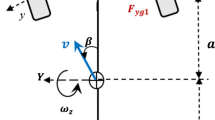Abstract
This paper presents a fuzzy longitudinal control system with car-following speed ranging from 0 to 120 km/h, thereby achieving the main functions of both adaptive cruise control (ACC) and Stop&Go control. A fuzzy longitudinal controller is synthesized by inputting the difference of the actual relative distance and the safe distance obtained from the preceding vehicle, and the relative speed, and then outputting the pulse-width-modulation (PWM) signal to control the output forces of the vacuum boosters. With the use of the high-level controller from dSPACE, the fuzzy control law is easily and rapidly implemented using Matlab/Simulink for the experimental car, and the controller’s parameters can be changed and updated by analyzing data based on the relative distance using Lidar, the speed of the host vehicle, the opening of the throttle and the position of the braking pedal. For the sake of safe driving, experimental results are conducted by simulating the various possible car-following conditions for the ACC and Stop&Go controllers, thereby obtaining virtually relative distances and speeds to tune the controller’s parameters and ensure the safety of the controller. Several car following experiments are conducted to show that the proposed fuzzy longitudinal controller is capable of achieving the requirements of comfort and safety, and giving a satisfactory performance at high and low speed conditions.
Similar content being viewed by others
References
Chen, J.W.: Fuzzy Neural Networks based Adaptive Cruise Control. MS thesis. Department of Electrical and Control Engineering, National Chiao Tung University (2002)
Blažič, S., Škrjanc, I.: Design and stability analysis of fuzzy model-based predictive control - A case study. J. Intell. Robot. Syst. 49, 279–292 (2007)
Furagaki, S., Kuroda, H., Minowa, T., Kayano, M., Yoshikawa, T., Takenaga, H., Nakamura, K., Takano, K.: An adaptive cruise control using wheel torque management technique. SAE Technical Paper. no. 980606 (1998)
Gerdes, J.C., Hedrick, J.K.: Vehicle speed and spacing control via coordinated throttle and brake actuation. Control Eng. Pract. 5(11), 1607–1614 (1997)
Holtzmann, H., Halfmann, C., Germann, S., Würtemberger, M., Isermann, R.: Longitudinal and lateral control and supervision of autonomous intelligent vehicles. Control Eng. Pract. 5(11), 1599–1605 (1997)
Huang, Y.J., Chang, S.H., Kuo, T.C.: Robust fuzzy output sliding control without the requirement of state measurement. J. Intell. Robot. Syst. 53, 169–182 (2008)
ISO 15622: Transport Information and Control Systems-Adaptive Cruise Control Systems-Performance Requirements and Test Procedures (2002)
Jones, W.D.: Keeping cars. IEEE 38(9), 40–45 (2001)
Kljuno, E., Williams, R.L. II: Vehicle simulation system: controls and virtual- reality- based dynamics simulation. J. Intell. Robot. Syst. 52, 79–99 (2008)
Lijima, T., Higashimata, A., Tange, S., Mizoguchi, K., Kamiyama, H., Iwasaki, K., Egawa, K.: Development of an adaptive cruise control system with brake actuation. SAE Technical Paper. no. 2000-01-1353 (2000)
Littlejohn, D., Fornari, T., Kuo, G., Fulmmer, B., Mooradian, A., Shipp, K., Elliott, J., Lee, K.: Performance, robustness, and durability of an automatic brake system for vehicle adaptive cruise control. SAE Technical Paper. no. 2004-01-0255 (2004)
Naranjo, J.E., Gonzalez, C., Reviejo, J., Garcia, R., Pedro, T.D.: Adaptive fuzzy control for inter-vehicle gap keeping. IEEE Trans. Intell. Transp. Syst. 4(3), 132–142 (2003)
Naranjo, J.E., Gonzalez, C., Reviejo, J., Garcia, R., Pedro, T.D.: ACC+ Stop&Go maneuvers with throttle and brake fuzzy control. IEEE Trans. Intell. Transp. Syst. 7(2), 213–225 (2006)
Noureldin, A., El-Shafie, A., Taha, M.R.: Optimizing neuro-fuzzy modules for data fusion of vehicular navigation systems using temporal cross-validation. Eng. Appl. Artif. Intell. 20, 49–61 (2007)
Person, M., Botling, F., Hesslow, E., Johnsson, R.: Stop&Go controller for adaptive cruise control. In: Proc. of IEEE International Conference on Control Applications, pp. 1692–1697. Kohala Coast -Island of Hawaii, Hawaii, USA (1999)
Prestl, W., Sauer T., Steinle, J., Tshchernoster, O.: The BMW Active Cruise Rajamani, R. and Zhu, C. (2002).: Semi-Autonomous Adaptive Cruise Control Systems. IEEE. 51(5), 1186–1192 (2000)
Riley, B., Kuo, G., Schwartz, B., Zumberge, J.: Development of a controlled braking strategy for vehicle adaptive cruise control. SAE Technical Paper. no. 2000-01-0109 (2000)
SAE J2399: Adaptive Cruise Control (ACC) Operating Characteristics and User Interface (2003)
Sanchez, F., Seguer, M., Freixa, A., Andreas, P., Sochaski, K., Holze, R.: From adaptive cruise control to active safety systems. SAE Technical Paper. no. 2001-01-3245 (2001)
Shi, P.H.: Design and Implementation of an FPGA-based Intelligent Cruise Control System. MS thesis, Department of Electrical and Control Engineering, National Chiao Tung University (2005)
Tanaka, K., Wang, H.O.: Fuzzy Control System Design and Analysis: a Linear Matrix Inequality Approach, 1st Ed. Wiley, Hoboken (2001)
Venhovens, P., Naab, K., Adiprasito, B.: Stop and Go cruise control. Int. J. Automot. Technol. 1(2), 61-69 (2000)
Ward, D., Bertram, T., Hiller, M.: Vehicle dynamics simulation for the development of an extended adaptive cruise control. IEEE Int. Conf. Advanced Intelligent Mechatronics. 730–735 (1999)
Wang, J., Rajamani, R.: Should adaptive cruise-control systems be designed to maintain a constant time gap between vehicles?. IEEE. 53(5), 1480–1490 (2004)
Widmann, G.R., Daniels, M.K., Hamilton, L., Humm, L., Riley, B., Schiffmann J.K., Schnelker, D.E., Wishshon, W.H.: Comparison of lidar- based and radar-based adaptive cruise control systems. SAE Technical Paper, no. 2000-01-0345 (2000)
Yi, K., Hong, J., Kwon, Y.D.: A vehicle control algorithm for Stop-and-Go Cruise control. Proc. Inst. Mech. Eng. Part D-J. Automob. Eng. 215(10), 1099–1115 (2001)
Żak, S.H.: Systems and Control. New York, Oxford University Press (2003)
Bingul, Z., Cook, G.E., Strauss, A.M.: Application of fuzzy logic to spatial thermal control in fusion welding. IEEE Trans. Ind. Appl. 36(6), 1523–1530, (2000)
Kizir, S., Bingul, Z., Oysu, C.: Fuzzy control of a real time inverted pendulum system. Lect. Notes Comput. Sci. 5177, 674–681 (2008)
Hirofumi, O., Ljubo, V.: Stop & Go vehicle longitudinal model. IEEE Int. Conf. Intell. Transport. Syst. 206–209, (2002)
Author information
Authors and Affiliations
Corresponding author
Rights and permissions
About this article
Cite this article
Tsai, CC., Hsieh, SM. & Chen, CT. Fuzzy Longitudinal Controller Design and Experimentation for Adaptive Cruise Control and Stop&Go. J Intell Robot Syst 59, 167–189 (2010). https://doi.org/10.1007/s10846-010-9393-z
Received:
Accepted:
Published:
Issue Date:
DOI: https://doi.org/10.1007/s10846-010-9393-z




